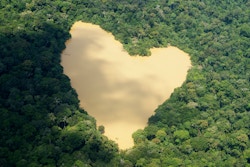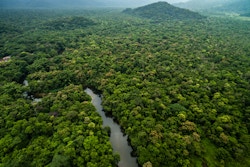The Amazon rainforest: the world's most important ecosystem
Half of the planet's rainforests have already disappeared. The Amazon is still the most extensive rainforest on earth, but regrettably, a large part of it is now in danger of disappearing for good. Our goal is to prevent that disaster.

GREEN CARPET: Peru holds the second largest area of rainforest of the countries in the Amazon region. This photo was taken in the country’s east.
The Amazon rainforest stretches across 5.5 million square kilometers/2.1 million square miles – an area far more extensive than the EU and more than half of the US. All figures describing some aspect of the Amazon tell us about the region’s unique status on the planet:
- The enormous Amazon river, with all its tributaries, contains 20 percent of the world’s flowing fresh water.
- Though the Amazon covers only four percent of the earth’s surface, it contains a third of all known terrestrial plant, animal, and insect species.
- The forest produces more than 50 percent of all the rain that falls in the Amazon region, and it probably affects rainfall patterns far outside South America.
- The Amazon rainforest contains 10 percent of all biomass on Earth. It means that when deforestation takes place, the vast amounts of carbon that the forest stores are released into the atmosphere as carbon dioxide, a greenhouse gas that contributes significantly to global warming.

DEPEND ON THE FOREST: The Yanomami in northern Brazil are among the many indigenous groups that depend on the rainforest for all of their essential needs.
How we work to save the Amazon
Getting recognition of indigenous peoples’ rights to their traditional lands has proven extremely effective in protecting the rainforest. Forests remain standing where their traditional populations secure the legal right to manage them.
For that reason, rights are at the heart of Rainforest Foundation Norway’s approach to preserving the Amazon rainforest. We work closely with our local partners on the political level in the various Amazon countries to ensure that the rights of indigenous peoples are recognized, strengthened, and upheld through law.
Our work in the region has one primary goal:
- The protection of the Amazon, with its current ecosystem intact.
To reach this goal, we have set an intermediate one:
- The protection of large, contiguous areas of rainforest in selected parts of the Amazon.
We work closely with several actors in the protection of several large, contiguous rainforest areas. As Brazil, Peru, and Colombia hold half of the remaining tropical rainforests of the world, we have a particular focus on these three countries in our work.
- The Yavari-Tapiche Territorial Corridor for the protection of isolated indigenous peoples in northeastern Peru
- The Pano-Arawak Territorial Corridor for the protection of isolated indigenous peoples in southeastern Peru
- The Territorial Corridor of 9 contiguous indigenous peoples in northwestern Peru
- 16 contiguous indigenous territories in the eastern Colombian Amazon
- 3 deforestation hotspot areas in the western Colombian Amazon
- Integrated management of seven contiguous indigenous territories in the Río Negro Basin and sustainable management of the Yanomami indigenous territory in the adjacent area.
- Integrated management of the Xingú basin in Brazil
- Integrated management of the Río Negro basin in Brazil and Colombia
- Management of contiguous territories and protected areas in the northeastern Brazilian Amazon
In these areas, we are working to exert influence on the authorities to establish new indigenous territories. Where territories have already been established, we provide assistance to the indigenous and other local communities to ensure the sustainable management of the territories, improved living standards, the perpetuation of their territorial protections, and ensuring that their rights are respected.
In order to achieve this, we work to set up and improve existing participatory processes that strengthen the political and legal frameworks for rainforest protection and the rights of indigenous and other forest-dependent communities in Brazil, Colombia, and Peru.
In order to address the main drivers behind the massive deforestation and human rights violations in the Amazon, we focus on selected commercial actors to help them change their policies and activities with regard to the Amazon and the commodities stemming from it.

PATROL: Two men from the Yanomami people patrol their territory in the Brazilian Amazon. They are on the lookout for illegal logging and gold mining. Photo: Thomas Nilsen/VG
A lush green home
The Amazon rainforest may be home to some 30 million people. Some 1.6 million of these inhabitants are indigenous, and they belong to more than 400 different indigenous groups. Some are isolated tribes who choose to avoid contact with the outside world.
Over thousands of years, the indigenous population of the Amazon has managed, protected, and enriched the rainforest while being a fully integrated part of it. Today, indigenous peoples have established their own organizations in all nine countries of the Amazon region. The indigenous movements play an essential role in the battle over this unique forest.
Deforestation and destruction
It has taken nature millions of years to create the Amazon rainforest, yet humans have destroyed large parts of it in only a few generations. Humans began damaging the forest when South America's modern states emerged. Since the 1950s, the Amazon rainforest has lost 18 percent of its original forest cover, and up to 28 percent of the remaining forest has been partially destroyed. This is mainly due to:
- Expansion of industrial agriculture and cattle ranching
- Oil and gas production
- Mining and logging
- A variety of infrastructure projects

OIL SPILL: The Amazon rainforest is rich in natural resources, including petroleum. Unfortunately, this is all too often what meets the eye when the petroleum has been extracted from the ground. This photo was taken in Peru.

EXPANDING: The rainforest is suffering from the fact that cattle ranching in the southern Amazon lays claim to enormous areas.

THE FRONTIER OF DEFORESTATION: The demand for various raw materials is the most important cause of the destruction of the Amazon rainforest. Here a soy plantation in Xingu in Brazil.
The consequences of such devastation have been dire. The Amazon rainforest is a fragile ecosystem that is dependent on its massive size to survive. We do not know how long humans can continue damaging this rainforest before we reach the dreaded tipping point beyond which the damage will be so severe that the ecosystem breaks down and dies back by itself.
What we do know is that deforestation and forest degradation weaken the capacity of the remaining forest to produce rain. As a result, up to 65 percent of the Amazon is in danger of turning into savannah in the course of the next 50 years. We also know that if all approved and planned industrial and infrastructure projects are carried out, half of the Amazon rainforest will disappear.




